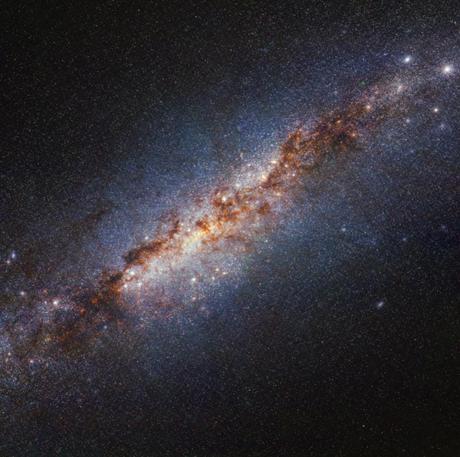The James Webb Space Telescope (JWST) has zoomed in on the heart of the Cigar Galaxy, a region of space ablaze with an explosive bout of star birth.
This starburst galaxy, also known as Messier 82 (M82), has a compact but turbulent environment at its core that could give scientists a clearer picture of how stars are born en masse, and how extreme environments shape the galaxies around them.
Located about 12 million light-years away in the constellation Ursa Major, M82 is forming stars ten times faster than our own relatively quiet galaxy, the Milky Way. The team imaged the core of this starburst galaxy with the JWST's Near-Infrared Camera (NIRCam) to investigate what conditions drive the formation of young stars.
Related: James Webb Space Telescope sees hints of exomoons forming in a child star system
"M82 has collected a variety of observations over the years because it can be considered the prototypical starburst galaxy," Alberto Bolatto, team leader and researcher at the University of Maryland, said in a statement. "Both Spitzer and Hubble Space Telescopes observed this target.
"The size and resolution of the JWST allows us to look at this star-forming galaxy and see all these beautiful new details."
How the JWST sees right through starbursts
Star formation is common throughout the cosmos, but has been able to maintain an air of mystery because gas and dust, which provide the raw material needed for star formation, also effectively shroud the process.
Although gas and dust absorb visible light very efficiently, infrared light can slip through this material. This means that the JWST, with its powerful and sensitive infrared view of the cosmos, is the perfect instrument to get to the heart of star birth.
The NIRCam images collected by Bolatto and colleagues also benefited from a special mode that prevented the bright young stars at M82's heart from overwhelming the instrument.

The JWST M82 shortwave infrared light image shows dark, reddish-brown dust tendrils working their way through M82's white, cigar-smoke, glowing core. Small green dots in the image represent regions of iron left over from supernova explosions of now-dead massive stars. Red-looking spots show areas where molecular hydrogen is heated by radiation from young stars.
"This image shows the power of the JWST," team member and University of Arizona scientist Rebecca Levy said in the statement. "Every white dot in this image is a star or a star cluster. We can start to distinguish all these small point sources, which will give us an accurate count of all the star clusters in this galaxy."
The galactic winds of a smoking cigar
When JWST's NIRCam imaged M82's core in infrared light, the star-forming region took on a strikingly fresh appearance. Suddenly, gaseous streams of galactic winds appeared, extending further from the core of the Milky Way than previously noticed, almost like a network of blood vessels extending from a biological heart rather than a galactic heart.
This galactic wind is driven by star formation and supernova death of older stars. Like lifeblood pumped through the blood vessels of the human body, the galactic wind moves elements around that enable galactic growth through further star formation, greatly affecting the body around it.
NIRCam was able to trace the structure of these galactic winds as they eject sooty chemical molecules known as polycyclic aromatic hydrocarbons (PAHs). Because PAHs are tiny dust grains that survive in cool areas but are destroyed by higher temperatures, this revealed how cold and hot components in the wind interact.
The fine structure of galactic winds in M82 was something the team did not expect to discover - nor did they expect to see any similarities in the shape of PAH emission and the structure of hot, ionized gas tendrils.
"It was unexpected to see that the PAH emission resembled ionized gas," Bolatto explains. "PAHs wouldn't live very long if exposed to such a strong radiation field, so perhaps they are constantly being replenished. It challenges our theories and shows us that further research is needed."
RELATED STORIES:
- James Webb Space Telescope notes first confirmation of a rocky planet
- James Webb Space Telescope's groundbreaking research into a planet-forming disk hints at future exoplanet discoveries
- James Webb Space Telescope reveals the atmospheres of alien planets like never before
The team hopes that further JWST observations of M82 and other starburst galaxies can help answer some lingering questions about star birth. The scientists will also combine these new images with complementary large-scale images of the Cigar Galaxy and its galactic winds.
Light spectra from this galaxy should help astronomers determine the accurate ages of the star clusters in M82. This in turn could reveal how long each stage of star formation lasts in starburst galactic environments.
"These amazing JWST images and our upcoming spectra will allow us to study how exactly the strong winds and shock fronts from young stars and supernovae can remove the gas and dust from which new stars are formed," said team member and European Space Agency (ESA). ) said scientist Torsten Böker in the statement. 'A detailed understanding of this 'feedback' cycle is important for theories of how the early universe evolved, because compact starbursts like the one in M82 were very common at high redshift.'
The team's research has been accepted for publication in The Astrophysical Journal.
